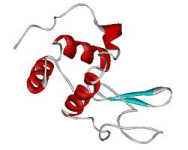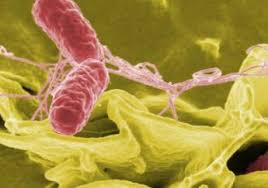| Lysozyme navigation: | Home | Copyright | Contact us | |

|
Lysozyme Decrease Diseases Caused by Salmonella
published: 18 Nov 2011 (3:32)
 |
| Salmonella bacterium. |
Bacterial growth can be inhibited by a process that rapidly cools the eggs as per Kevin Keener, an Associate Professor of Food Science. This cooling process involves saturation of the inside of an egg with carbon dioxide thereby altering the pH within. This increase in carbon dioxide levels and the decrease of pH inside an egg facilitate the activity of a protective enzyme called lysozyme.
Kevin Keener’s work published in the Journal of Poultry Science focuses on the association of lysozyme activity with carbon dioxide and pH levels. This would mean that increasing the lysozyme activity would amplify the defence of an egg against harmful pathogens like Salmonella. A newly laid egg is saturated with carbon dioxide and has a neutral pH of 7. As it ages, its pH rises to approximately 9 because of the seepage of carbon dioxide. As the environment inside an egg tends to become basic, it becomes unsuitable for lysozyme, thus diminishing its activity.
Keener conducted an experiment in which he saturated the lysozyme in a purified egg white with carbon dioxide. He then measured lysozyme activity at various pH levels. The results of his experiment confirmed that addition of carbon dioxide increased the activity of lysozyme at high as well as low ph. The increase in the lysozyme activity was found to be as much as 50 per cent. Keener further established a cooling process to artificially create conditions that would increase the lysozyme activity in an egg. When cooled, the egg shell sucks in the carbon dioxide and thus returns to its initial defence mode. This increased duration of lysozyme activity inside an egg would help the egg in killing harmful bacteria itself.
The cooling technology created by Keener employs carbon dioxide ‘snow’ to swiftly lower the temperature inside an egg. The eggs are placed in a cooling chamber where carbon dioxide gas is produced at minus 10 degrees Fahrenheit. When circulated around the eggs in the chamber, this gas forms a thin layer of ice in the eggshell. Following treatment, the ice layer melts, thus lowering the temperature of the interior of an egg to less than 45 degrees Fahrenheit. Resistance to expansion from a thin ice layer prevents the cracking of the egg shell during the cooling process.
Keener’s study claims that if cooled and stored below 45 degrees Fahrenheit within 12 hours, eggs can eliminate Salmonella themselves, which could save as many as 100,000 Americans from infections caused by Salmonella from eggs.
P. Banerjee, K. M. Keener, V. D. Lukito. Influence of carbon dioxide on the activity of chicken egg white lysozyme. Poultry Science, 2011; 90 (4): 889 DOI: 10.3382/ps.2010-00854
Other news pages: 1
News
Lysozome deficient cell has better immunity against SalmonellaBy replacing one of the most important soldiers ...
Lysozyme Decrease Diseases Caused by SalmonellaWhen a hen lays an egg, it gives the egg some ...
Other news pages:
1
| Copyright 2006-... by Lysozyme.co.uk |